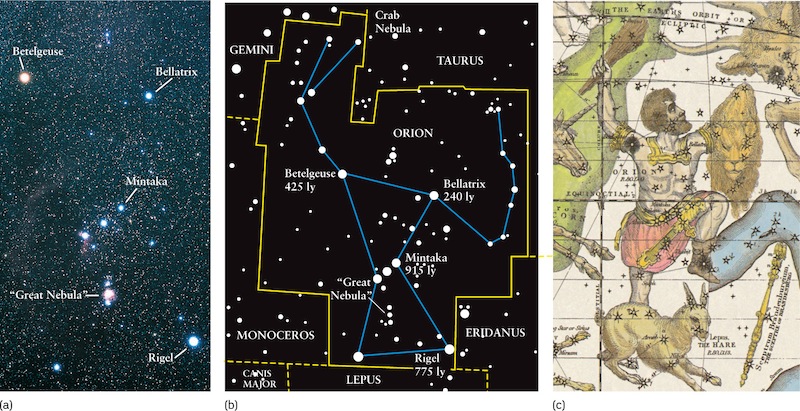2-2 Eighty-eight constellations cover the entire sky
The constellations provide a convenient framework for stating the position of an object in the heavens
Looking at the sky on a clear, dark night, you might think that you can see millions of stars. Actually, the unaided human eye can detect only about 6000 stars. Because half of the sky is below the horizon at any one time, you can see at most about 3000 stars. When ancient peoples looked at these thousands of stars, they sometimes imagined that groupings of stars traced out pictures in the sky. Astronomers still refer to these groupings, called constellations (from the Latin for “group of stars”).
You may already be familiar with some of these pictures or patterns in the sky, such as the Big Dipper, which is actually part of the large constellation Ursa Major (the Great Bear). Many constellations, such as Orion in Figure 2-2, have names derived from the myths and legends of antiquity. Although some star groupings vaguely resemble the figures they are supposed to represent (see Figure 2-2c), most do not.

Three Views of Orion The constellation Orion is easily seen on nights from December through March. (a) This photograph of Orion shows many more stars than can be seen with the naked eye. (b) A portion of a modern star atlas shows the distances in light-years (ly) to some of the stars in Orion. The yellow lines show the borders between Orion and its neighboring constellations (labeled in capital letters). (c) This fanciful drawing from a star atlas published in 1835 shows Orion the Hunter as well as other celestial creatures.
The term “constellation” has a broader definition in present-day astronomy. On modern star charts, the entire sky is divided into 88 regions, each of which is called a constellation. For example, the constellation Orion is now defined to be an irregular patch of sky whose borders are shown in Figure 2-2b. When astronomers refer to the “Great Nebula” M42 in Orion, they mean that as seen from Earth this nebula appears to be within Orion’s patch of sky. Some constellations cover large areas of the sky (Ursa Major being one of the biggest) and others very small areas (Crux, the Southern Cross, being the smallest). But because the modern constellations cover the entire sky, every star lies in one constellation or another.
23
CAUTION!
When you look at a constellation’s star pattern, it is tempting to conclude that you are seeing a group of stars that are all relatively close together. In fact, most of these stars are nowhere near one another. As an example, Figure 2-2b shows the distances in light-years from Earth to four stars in Orion. Although Bellatrix (Arabic for the “Amazon”) and Mintaka (“the belt”) appear to be close to each other, Mintaka is actually more than 600 light-years farther away from us. The two stars only appear to be close because they are in nearly the same direction as seen from Earth. The same illusion often appears when you see an airliner’s lights at night. It is very difficult to tell how far away a single bright light is, which is why you can mistake an airliner a few kilometers away for a star trillions of times more distant.
 The star names shown in Figure 2-2b are from the Arabic language. For example, Betelgeuse means “armpit,” which makes sense when you look at the star atlas drawing in Figure 2-2c. Other types of names are also used for stars. For example, Betelgeuse is also known as a Orionis because it is the brightest star in Orion (a, or alpha, is the first letter in the Greek alphabet).
The star names shown in Figure 2-2b are from the Arabic language. For example, Betelgeuse means “armpit,” which makes sense when you look at the star atlas drawing in Figure 2-2c. Other types of names are also used for stars. For example, Betelgeuse is also known as a Orionis because it is the brightest star in Orion (a, or alpha, is the first letter in the Greek alphabet).
CAUTION!
A number of unscrupulous commercial firms offer to name a star for you for a fee. The money that they charge you for this “service” is real, but the star names are not; none of these names is recognized by astronomers. If you want to use astronomy to commemorate your name or the name of a friend or relative, consider making a donation to your local planetarium or science museum. The money will be put to much better use!
CONCEPT CHECK 2-1
If Jupiter is reported to be in the constellation of Taurus the Bull, does Jupiter need to be within the outline of the bull’s body? Why or why not?